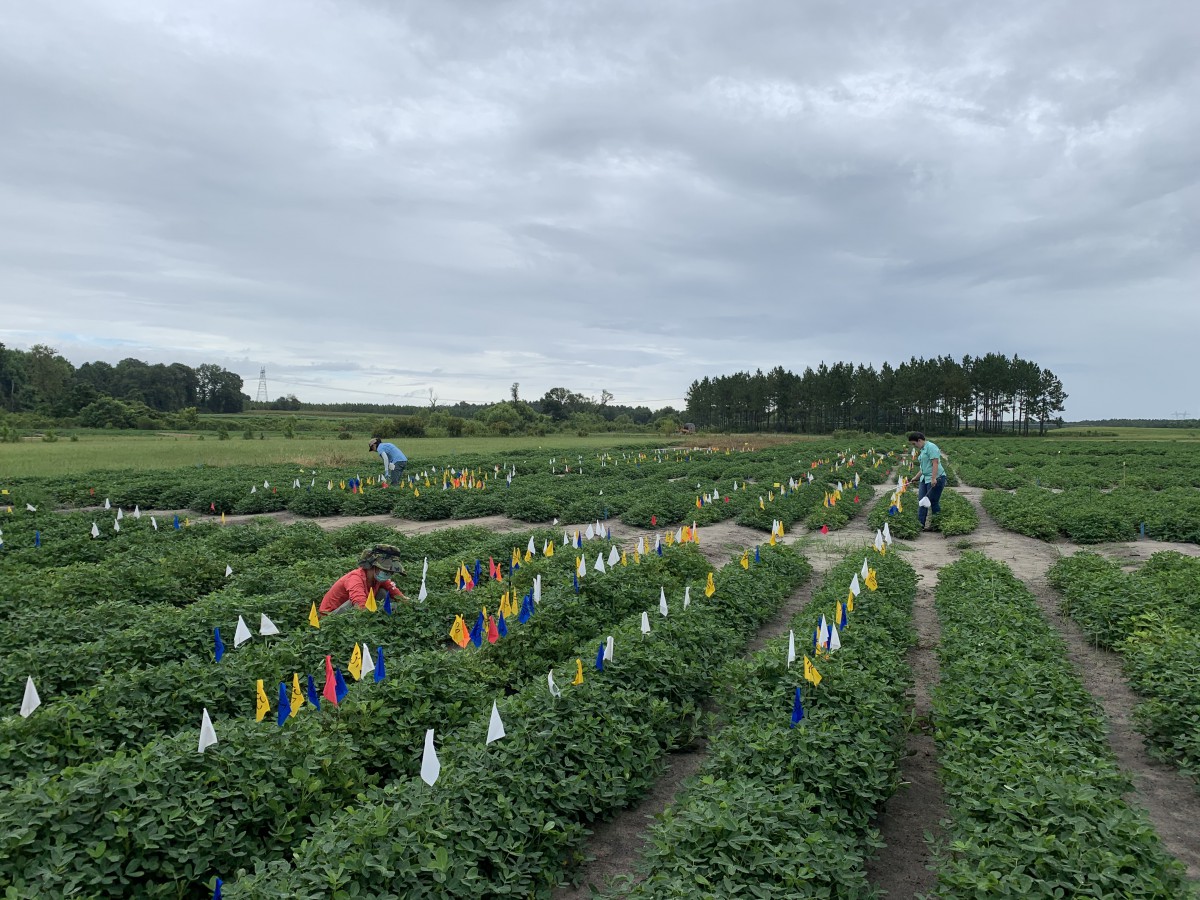Introduction
Georgia is one of the nation’s top summer squash producers. Unfortunately, insects love the warmth and humidity of the Southeast, and they thrive in Georgia’s squash cropping systems. Insects cause direct injury to squash by feeding on the leaves and fruit, and they can transmit devastating viruses that make fruit unmarketable. If infections are serious enough, viruses can even kill plants. Whiteflies are some of the most important vectors—or carriers—of crop viruses. They are responsible for transmitting at least four viruses in Georgia’s squash crops, several of which can infect a single plant at the same time (called “mixed infection”).

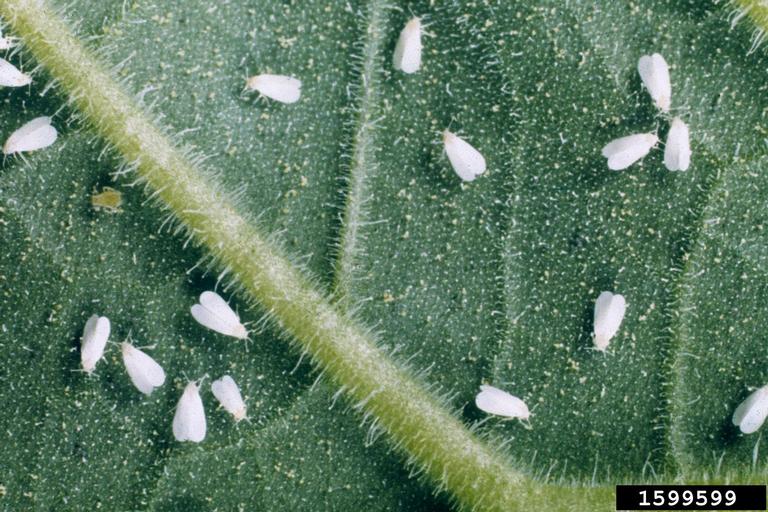
Whitefly-transmitted viruses can have major impacts on squash yields—whiteflies can easily infect 100% of plants in a field, resulting in 30-50% yield losses on average. Farmers rely on insecticides to manage whiteflies and curb the effects of viruses, but insecticide resistance is a major concern. Non-chemical tactics, like the use of floating row covers and UV-reflective mulches are also useful tools used by growers. In this post, we will outline the major viruses transmitted by whiteflies in Georgia’s squash crops and summarize current approaches to management.
Squash Production in Georgia
Georgia is one of the top producers of fresh market squash in the US in yield and acreage. On average, Georgia farmers plant 3,550 acres of squash and produce 480,000 lb. per year. In 2017, Georgia’s squash production was worth USD$22.2 million.
Although both “summer” and “winter” squash varieties (Cucurbita spp.) are grown in Georgia, summer squash is more widely grown. This includes thin-skinned fruits like zucchini, yellow, and patty pan squash, all of which are varieties of the species Cucurbita pepo.
What are Whiteflies?
Whiteflies are insects in the order Hemiptera (true bugs) and family Aleyrodidae. Whiteflies aggregate on the undersides of leaves and use their piercing-sucking mouthparts to feed on plant phloem, the tissue responsible for transporting sugars and other metabolites inside plants. Whiteflies tap into phloem channels to extract sap, a sugar-water mixture high in carbohydrates. It often takes a whitefly 15-30 minutes of probing the plant epidermis with its mouthparts to reach the phloem. At this stage, a viruliferous whitefly (one that is carrying a plant virus) can transmit the virus to the plant through its saliva or on its mouthparts.

In Georgia, the most economically important whitefly species is the silverleaf whitefly (SLWF), Bemisia tabaci, also known as the sweetpotato whitefly. Rather than being a single species, B. tabaci actually inclydes 40+ cryptic species that are extremely difficult to differentiate from one another. Bemisia tabaci Middle East-Asia Minor 1 (MEAM1; previously ‘B’ biotype) is the most common whitefly pest in Georgia. It infests and transmits viruses in multiple vegetable crops, including squash, tomatoes, beans, and cole crops. Another species, B. tabaci Mediterranean (MED; previously ‘Q’ biotype) has also spread throughout the US but is primarily found in greenhouses rather than in open cropping systems. Bemisia tabaci MEAM1 and MED infest cropping systems around the world and are the two most economically significant B. tabaci species.
Why Are Whiteflies a Problem?
Whiteflies injure crops in two ways: 1) by feeding and 2) by transmitting viruses and other plant pathogens. Unlike adults, immature whiteflies are immobile and remain stationary on the undersides of leaves until they develop into adults. Like adults, they also feed on sap by tapping into plant phloem. Persistent feeding by immature whiteflies can cause Squash Silverleaf Disorder (SSL), a condition that reduces photosynthesis, stunts plants, and diminishes fruit quality. SSL is purely the result of whitefly feeding and is not caused by a plant pathogen. The leaf silvering caused by SSL is due to structural changes within the leaf—the epidermal tissues separate, creating air pockets. Symptoms may begin to appear on new leaves after immatures have been feeding for several days.

In addition to feeding-related damage, whiteflies are major transmitters of plant viruses. Insect-vectored viruses are the biggest threat to squash production in Georgia. There are at least four major viruses in Georgia squash that are transmitted by whiteflies: cucurbit leaf crumple virus (CuLCrV), cucurbit yellow stunting disorder virus (CYSDV), cucurbit chlorotic yellows virus (CCYV), and squash vein yellowing virus (SqVYV). Symptoms of these viruses often look similar, and mixed infections are common, so molecular testing is the most reliable way to determine which viruses are present in a squash field.
Cucurbit leaf crumple virus (CuLCrV)
Cucurbit leaf crumple virus is in the genus Begomovirus and family Geminiviridae. Like other begomoviruses, CuLCrV is transmitted by silverleaf whiteflies. Whiteflies acquire the virus by feeding on plants that are already infected. These may be other crops in the area or weeds surrounding squash fields. These other plants act as reservoirs for the virus when squash is not in season. Whiteflies must feed on an infected plant for at least 30 minutes to acquire CuLCrV, and they can transmit the virus to healthy plants 6-8 hours later. Whiteflies transmit CuLCrV and other begomoviruses in a persistent manner. This means that the virus replicates inside the body of the insect, which can then spread the virus to healthy plants for the rest of its lifetime.
Squash plants infected with CuLCrV have curled or crumpled leaves, yellowing between leaf veins, and dead tissue along leaf edges. Severe infections can stunt plants and cause distorted growth. CuLCrV can make yellow squash unmarketable by distorting fruit shape and causing green streaking. On the other hand, zucchini plants are generally still able to produce marketable fruit despite foliar symptoms. As of now, there are no squash cultivars with confirmed resistance to CuLCrV. Along with squash, other cucurbit crops, like cucumber, pumpkin, and melon can also become infected with CuLCrV.
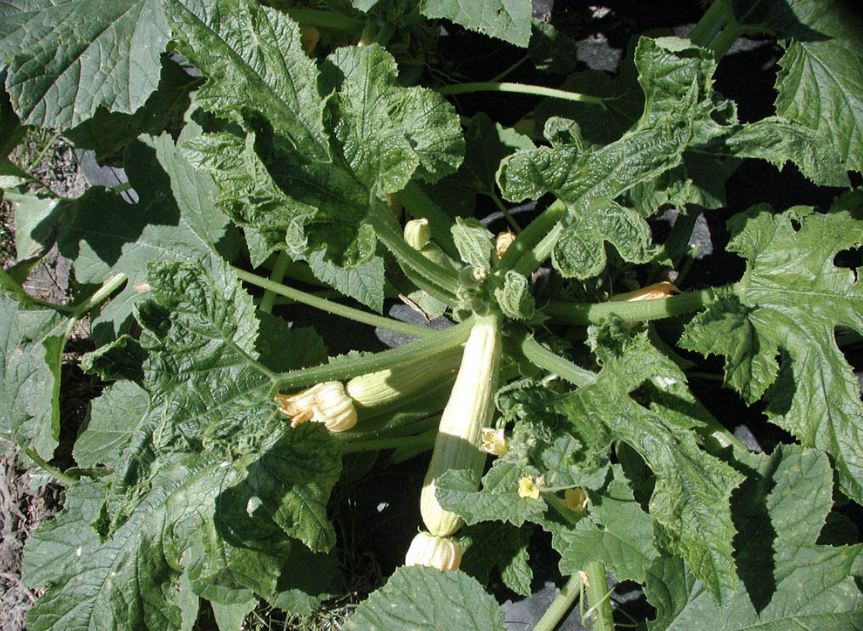
Cucurbit yellow stunting disorder virus (CYSDV)
Unlike CuLCrV, Cucurbit yellow stunting disorder virus is in the genus Crinivirus and the family Closteroviridae. CYSDV was first observed in Georgia in 2016 in cucumber, cantaloupe, and yellow squash fields. It infects most melon crops, zucchini and yellow squash, cucumber, and a range of non-cucurbit crops and wild plants, like okra, lettuce, lambsquarters, and alfalfa. As with other viruses, these non-squash hosts can act as reservoirs for CYSDV until squash season arrives. Bemisia tabaci MEAM 1 can then transmit the virus to young squash plants while feeding.
Silverleaf whiteflies transmit this virus semipersistently. This means that they carry the virus for a shorter amount of time than persistent viruses, like CuLCrV. The virus may be attached to the mouthparts or temporarily stored in the gut, rather than replicating inside the insect’s body. For this reason, whiteflies can only transmit semipersistent viruses, like CYSDV, for several hours to several days. After this time, they must re-acquire the virus from infected plant material to continue transmitting it to new plants.
Older leaves of CYSDV-infected squash develop spots of discoloration or chlorosis. Leaves may become brittle and roll up on the edges. Severely infected plants are often stunted. CYSDV is commonly in mixed infection with CuLCrV.

Cucurbit chlorotic yellows virus (CCYV)
Like CYSDV, Cucurbit chlorotic yellows virus is in the genus Crinivirus and is spread semipersistently by the silverleaf whitefly. Although CCYV mostly infects melons, it was first reported in squash in Georgia in 2020. Symptoms of the virus, like yellowing of leaves, are indistinguishable from CYSDV. Mixed infections of CuLCrV, CYSDV, and CYSDV are common in Georgia.
Squash vein yellowing virus (SqVYV)
Squash vein yellowing virus (SqVYV) is in the genus Potyvirus and family Potyviridae. As with CYSDV and CCYV, it is transmitted semipersistently by whiteflies. Whiteflies can acquire SqVYV after one hour of feeding and transmit it to healthy squash plants two hours later.
Unlike the other viruses discussed here, SqVYV only infects cucurbits (plants in the family Cucurbitaceae). Along with crops, SqVYV may infect cucurbit weeds surrounding crop fields when squash crops aren’t in season. The veins on leaves of SqVYV-infected plants turn yellow, leaves wilt, vines experience die-off, and fruit may become discolored and unmarketable.
Management Tactics
Because whitefly- or virus-resistant squash varieties are not available, we can only manage viruses by managing whiteflies and protecting plants from whitefly exposure. This is extremely difficult, as only one whitefly can transmit a virus to a plant.
Cultural Tactics
There are several non-chemical tactics that can be used to manage whiteflies and reduce virus transmission. UV-reflective mulch (silver plastic mulch), installed on top of the soil, physically reflects light. Some researchers think this disorients whiteflies and prevents them from landing on squash plants. Because fewer whiteflies are landing on plants, less feeding takes place. And if there’s less feeding, there’s less virus transmission and squash silverleaf disorder.

Row covers made of fine mesh netting physically exclude whiteflies and prevent them from coming into contact with squash plants. Row covers that are installed at planting and removed when plants begin flowering are an excellent way to protect young plants when they’re most susceptible to viruses. Even if plants become infected after the row covers are removed, by that time they have been able to develop robust defenses and can still produce profitable squash yields later in the season. Row covers can also be used in greenhouses, where squash seedlings are often grown before being transplanted to open fields.

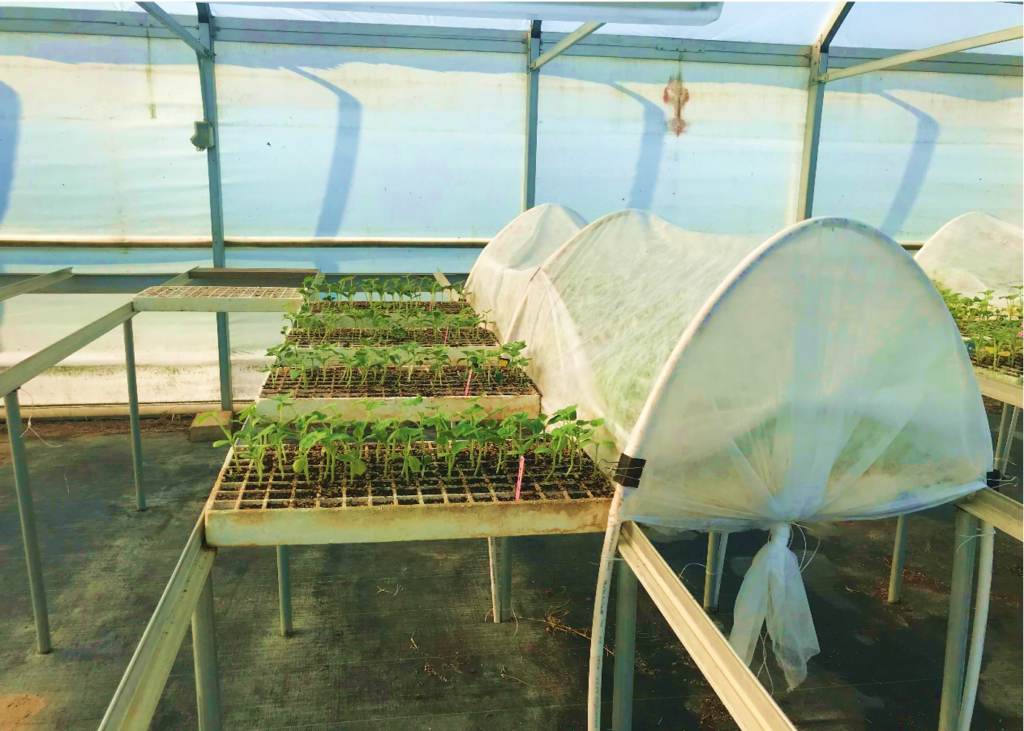
Spraying or physically removing cucurbit weeds and other plants that act as virus reservoirs is another option for minimizing virus inoculum around crop fields. Rotating crops, especially other virus hosts, may also keep whitefly populations from building up in one area over time.
Chemical Tactics
Even when multiple cultural tactics are used, insecticides may be needed to knock down whitefly populations. Regular scouting for whiteflies and virus symptoms can help growers know where “hotspots” are or when it’s appropriate to apply insecticides. Neonicotinoids, like imidacloprid (Admire Pro), are commonly used in southeastern squash production. However, B. tabaci populations around the world have already developed resistance to neonicotinoids and other frequently used insecticides. It’s important that growers rotate products from various chemical classes that have differing modes of action. Some insecticides, like cyantraniliprole (Exirel) and flupyradifurone (Sivanto Prime) may reduce whitefly feeding or alter behavior, which can ultimately reduce the spread of viruses.
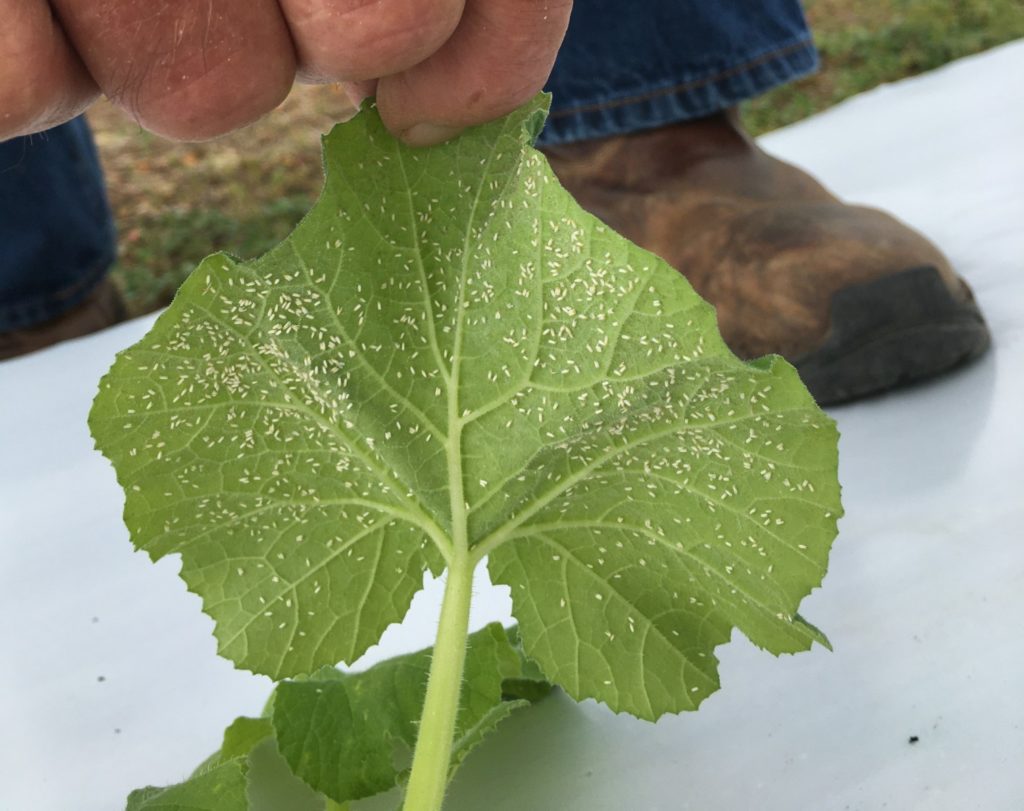
Conclusion
Bemisia tabaci whiteflies and the viruses they transmit are one of the biggest threats to squash production in the southeastern U.S. Cucurbit leaf crumple virus, cucurbit yellow stunting disorder virus, cucurbit chlorotic yellows virus, and squash vein yellowing virus infect squash plants singly or in mixed infections. They cause disease symptoms that stunt plants, distort growth, and reduce yields. Without access to resistant crop varieties, the only way to minimize viruses is by managing whiteflies and protecting plants. Growers must stack cultural and chemical management tactics to achieve the best control and ensure yields are still profitable.
The Srinivasan Lab team has a peer-reviewed journal article under review that discusses this topic in more detail and uses original research to support management recommendations. Stay tuned for a publication date!
References
Adkins, S., S. E. Webb, D. Achor, P. D. Roberts, and C. A. Baker. 2007. Identification and characterization of a novel whitefly-transmitted member of the family Potyviridae isolated from cucurbits in Florida. Phytopathology. 97: 145–154.
Adkins, S., C. G. Webster, C. S. Kousik, S. E. Webb, P. D. Roberts, P. A. Stansly, and W. W. Turechek. 2011. Ecology and management of whitefly-transmitted viruses of vegetable crops in Florida. Virus Res. 159: 110–114.
Boyhan, G. E., D. M. Granberry, and W. T. Kelley. 2009. Squash commercial vegetable production. Univ. Georg. Coop. Ext. Circ. 527.
Brown, J. K., D. R. Frohlich, and R. C. Rosell. 1995. The sweetpotato or silverleaf whiteflies: Biotypes of Bemisia tabaci or a species complex? Annu. Rev. Entomol. 40: 511–534.
Castle, S. J., J. P. Palumbo, and P. Merten. 2017. Field evaluation of cucurbit yellow stunting disorder virus transmission by Bemisia tabaci. Virus Res. 241: 220–227.
Coolong, T. 2017. Yellow squash and zucchini cultivar evaluation in Georgia. Horttechnology. 27: 296–302.
Csizinszky, A. A., D. J. Schuster, and J. B. Kring. 1997. Evaluation of color mulches and oil sprays for yield and for the control of silverleaf whitefly, Bemisia argentifolii (Bellows and Perring) on tomatoes. Crop Prot. 16: 475–481.
Csizinszky, A. A., D. J. Schuster, and J. E. Polston. 1999. Effect of ultraviolet-reflective mulches on tomato yields and on the silverleaf whitefly. HortScience. 34: 911–914.
De Barro, P. J., S. S. Liu, L. M. Boykin, and A. B. Dinsdale. 2011. Bemisia tabaci: A statement of species status. Annu. Rev. Entomol. 56: 1–19.
Dutta, B., B. Myers, T. Coolong, R. Srinivasan, and A. Sparks. 2018. Whitefly-transmitted plant viruses in South Georgia. Univ. Georg. Coop. Ext. Bull. 1507.
Gadhave, K. R., B. Dutta, T. Coolong, A. N. Sparks, S. Adkins, and R. Srinivasan. 2018. First report of Cucurbit yellow stunting disorder virus in Cucurbits in Georgia, United States. Plant Heal. Prog. 19: 9–10.
Gadhave, K. R., S. Gautam, B. Dutta, T. Coolong, S. Adkins, and R. Srinivasan. 2020. Low frequency of horizontal and vertical transmission of cucurbit leaf crumple virus in whitefly Bemisia tabaci Gennadius. Phytopathology. 110: 1235–1241.
Hagen, C., M. R. Rojas, T. Kon, and R. L. Gilbertson. 2008. Recovery from Cucurbit leaf crumple virus (family Geminiviridae, genus Begomovirus) infection is an adaptive antiviral response associated with changes in viral small RNAs. Phytopathology. 98: 1029–1037.
Horowitz, A. R., M. Ghanim, E. Roditakis, R. Nauen, and I. Ishaaya. 2020. Insecticide resistance and its management in Bemisia tabaci species. J. Pest Sci. (2004). 93: 893–910.
Kavalappara, S. R., H. Milner, A. N. Sparks, C. McGregor, W. M. Wintermantel, and S. Bag. 2021a. First report of cucurbit chlorotic yellows virus in association with other whitefly-transmitted viruses in squash (Cucurbita pepo) in Georgia. Plant Dis. 105: 1862.
Kavalappara, S. R., H. Milner, N. C. Konakalla, K. Morgan, A. N. Sparks, C. Mcgregor, A. K. Culbreath, W. M. Wintermantel, and S. Bag. 2021b. High throughput sequencing-aided survey reveals widespread mixed infections of whitefly-transmitted viruses in cucurbits in Georgia, USA. Viruses. 13: 988.
Keinath, A. P., K. S. Ling, S. Adkins, D. K. Hasegawa, A. M. Simmons, S. Hoak, H. C. Mellinger, and C. S. Kousik. 2018. First report of cucurbit leaf crumple virus infecting three cucurbit crops in South Carolina. Plant Heal. Prog. 19: 322–323.
Li, J., X. Liang, X. Wang, Y. Shi, Q. Gu, Y. W. Kuo, B. W. Falk, and F. Yan. 2016. Direct evidence for the semipersistent transmission of cucurbit chlorotic yellows virus by a whitefly vector. Sci. Rep. 6.
Li, M., J. Hu, F. C. Xu, and S. S. Liu. 2010. Transmission of tomato yellow leaf curl virus by two invasive biotypes and a Chinese indigenous biotype of the whitefly Bemisia tabaci. Int. J. Pest Manag. 56: 275–280.
Liburd, O. E., T. W. Nyoike, and J. M. Razze. 2008. Biology and management of whiteflies in sustainable field production of cucurbits. Univ. Florida/IFAS Ext. Publ. #ENY-848.
Mansour, A., and A. Al-Musa. 1992. Tomato yellow leaf curl virus: host range and virus‐vector relationships. Plant Pathol. 41: 122–125.
McAuslane, H. J., J. Chen, R. Bruce Carle, and J. Schmalstig. 2004. Influence of Bemisia argentifolii (Homoptera: Aleyrodidae) infestation and squash silverleaf disorder on zucchini seedling growth. J. Econ. Entomol. 97: 1096–1105.
McKenzie, C. L., J. A. Bethke, F. J. Byrne, J. R. Chamberlin, T. J. Dennehy, A. M. Dickey, D. Gilrein, P. M. Hall, S. Ludwig, R. D. Oetting, L. S. Osborne, L. Schmale, and R. G. Shatters. 2012. Distribution of Bemisia tabaci (Hemiptera: Aleyrodidae) biotypes in North America after the Q invasion. J. Econ. Entomol. 105: 753–766.
Mehta, P., J. A. Wyman, M. K. Nakhla, and D. P. Maxwell. 1994. Transmission of tomato yellow leaf curl geminivirus by Bemisia tabaci (Homoptera: Aleyrodidae). J. Econ. Entomol. 87: 1291–1297.
Nauen, R., P. Jeschke, R. Velten, M. E. Beck, U. Ebbinghaus-Kintscher, W. Thielert, K. Wölfel, M. Haas, K. Kunz, and G. Raupach. 2014. Flupyradifurone: A brief profile of a new butenolide insecticide. Pest Manag. Sci. 71: 850–862.
Nyoike, T. W., O. E. Liburd, and S. E. Webb. 2008. Suppression of whiteflies, Bemisia tabaci (Hemiptera: Aleyrodidae) and incidence of cucurbit leaf crumple virus, a whitefly-transmitted virus of zucchini squash new to Florida, with mulches and imidacloprid. Florida Entomol. 91: 460–465.
Prabhaker, N., S. Castle, and T. M. Perring. 2014. Baseline susceptibility of Bemisia tabaci B biotype (Hemiptera: Aleyrodidae) populations from California and Arizona to spirotetramat. J. Econ. Entomol. 107: 773–780.
Rosen, R., S. Kanakala, A. Kliot, B. Cathrin Pakkianathan, B. A. Farich, N. Santana-Magal, M. Elimelech, S. Kontsedalov, G. Lebedev, M. Cilia, and M. Ghanim. 2015. Persistent, circulative transmission of begomoviruses by whitefly vectors. Curr. Opin. Virol. 15: 1–8.
Schuster, D. J., J. B. Kring, and J. F. Price. 1991. Association of the sweetpotato whitefly with a silverleaf disorder of squash. HortScience. 26: 155–156.
Seal, S. E., F. VandenBosch, and M. J. Jeger. 2006. Factors influencing begomovirus evolution and their increasing global significance: Implications for sustainable control. CRC. Crit. Rev. Plant Sci. 25: 23–46.
Shrestha, D., H. J. McAuslane, S. T. Adkins, H. A. Smith, N. Dufault, J. Colee, and S. E. Webb. 2017. Host-mediated effects of semipersistently transmitted squash vein yellowing virus on sweetpotato whitefly (Hemiptera: Aleyrodidae) behavior and fitness. J. Econ. Entomol. 110: 1433–1441.
Smith, H. A., C. A. Nagle, C. A. MacVean, and C. L. McKenzie. 2016. Susceptibility of Bemisia tabaci MEAM1 (Hemiptera: Aleyrodidae) to imidacloprid, thiamethoxam, dinotefuran and flupyradifurone in South Florida. Insects. 7: 1–12.
Summers, C. G., and J. J. Stapleton. 2002. Use of UV reflective mulch to delay the colonization and reduce the severity of Bemisia argentifolii (Homoptera: Aleyrodidae) infestations in cucurbits. Crop Prot. 21: 921–928.
Tamang, P., W. M. Wintermantel, and J. D. Mccreight. 2019. Suppression of cucurbit chlorotic yellows virus accumulation in melon breeding line MR-1 under natural infection in Imperial Valley, California. Cucurbit Genetics Cooperative Report. 42: 26–29.
(USDA NASS) United States Department of Agriculture National Agricultural Statistics Service. 2020. Vegetables 2019 summary.
Webb, S. E., S. Adkins, and S. R. Reitz. 2012. Semipersistent whitefly transmission of squash vein yellowing virus, causal agent of viral watermelon vine decline. Plant Dis. 96: 839–844.
Webb, S. E., F. Akad, T. W. Nyoike, O. E. Liburd, and J. E. Polston. 2007. Whitefly-transmitted cucurbit leaf crumple virus in Florida. Univ. Florida/IFAS Ext. Publ. #ENY-477. 1–3.
Wintermantel, W. M., L. L. Hladky, A. A. Cortez, and E. T. Natwick. 2009. A new expanded host range of cucurbit yellow stunting disorder virus includes three agricultural crops. Plant Dis. 93: 685–690.
Yokomi, R. K., K. A. Hoelmer, and L. S. Osborne. 1990. Relationships between the sweetpotato whitefly and the squash silverleaf disorder. Phytopathology. 80: 895–900.
Zhang, J., L. Wang, Y. Zheng, J. Feng, Y. Ruan, S. Diao, S. Chen, B. Jiang, Z. Shen, and H. Lu. 2017. Effects of Bemisia tabaci (Gennadius) infestation and squash silverleaf disorder on Cucurbita pepo L. leaf. Sci. Hortic. (Amsterdam). 217: 8–16.
